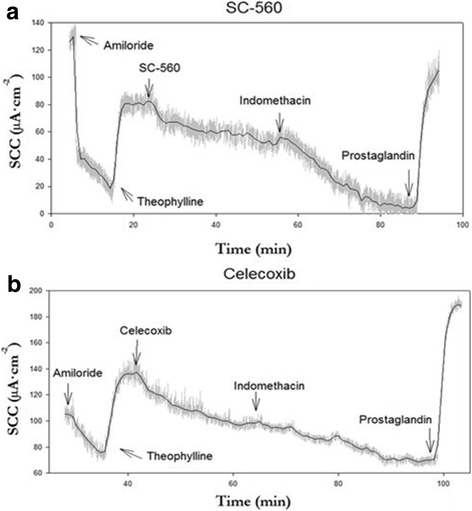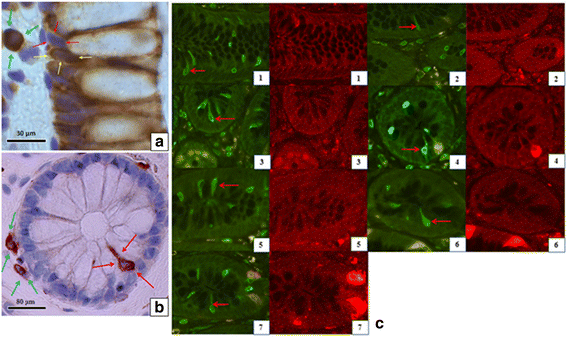Combined activity of COX-1 and COX-2 is increased in non-neoplastic colonic mucosa from colorectal neoplasia patients
- PMID: 29486731
- PMCID: PMC5830335
- DOI: 10.1186/s12876-018-0759-1
Combined activity of COX-1 and COX-2 is increased in non-neoplastic colonic mucosa from colorectal neoplasia patients
Abstract
Background: Cyclooxygenase (COX) activity is increased in endoscopic normal colonic mucosa from patients with colorectal neoplasia (CRN). COX-2 is thought to be the predominant COX isozyme involved in neoplasia. Meanwhile, relative contributions of COX-1 and COX-2 isoforms are unknown. Knowledge about their mutual activity in colonic mucosa is important for diagnostics and targeted therapy for CRN. The aim of this study was to assess the relative function, expression and localization of COX-1 and COX-2 enzymes in colonic non-neoplastic human mucosa and thereby to potentially reveal a mucosal disease predisposition for better treatment.
Methods: Biopsies were pinched from normal appearing colonic mucosa in patients undergoing endoscopy. Ussing chamber technique was applied for an indirect assessment of epithelial activity, RT-qPCR for expression and immunohistochemistry for localization of COX-1 and COX-2 enzymes in patients without (ctrls) and with a history of CRN (CRN-pts).
Results: Combined COX-1 and COX-2 activity was higher in CRN-pts, p = 0.036. COX-2 was primarily localized in absorptive cells, while COX-1 appeared to be restricted to nonenteroendocrine tuft cells of the colonic epithelium.
Conclusions: In biopsies from endoscopic normal appearing colonic mucosa, combined activity of COX-1 and COX-2 enzymes is increased in CRN-pts compared with ctrls. This indicates that COX-1 and COX-2 together contribute to an increased proliferation process. Of note, in colonic epithelial cell lining, the COX-1 enzyme seems localized in tuft cells.
Keywords: Biopsy; Carcinogenesis; Cyclooxygenase; Endoscopic; Short circuit current (SCC); Tuft cells.
Conflict of interest statement
Ethics approval and consent to participate
The study protocol was approved by the scientific Ethical Committee of Copenhagen (H-3-2013-107) and the Danish Data Protection Agency approved the study protocol (BBH-2013-024, I-suite no: 02342). The study was conducted in accordance with the Helsinki declaration. All patients participating gave written informed consent.
Consent for publication
Not applicable.
Competing interests
The authors declare that they have no competing interests.
Publisher’s Note
Springer Nature remains neutral with regard to jurisdictional claims in published maps and institutional affiliations.
Figures

 markers are hypothetically increased in CRN, thereby increasing cell proliferation and carcinogenesis. PGE2: prostaglandin E2, cAMP: cyclic adenosine monophosphate, AMP: adenosine monophosphate, ATP: adenosine triphosphate, COX: cyclooxygenase, CRN: colorectal neoplasia, Gs: stimulatory heterotrimeric G protein, ABCC5: ATP-binding cassette transporter C5, EP4: prostaglandin receptor subtype 4, SC-560: selective COX-1 inhibitor, celecoxib: selective COX-2 inhibitor
markers are hypothetically increased in CRN, thereby increasing cell proliferation and carcinogenesis. PGE2: prostaglandin E2, cAMP: cyclic adenosine monophosphate, AMP: adenosine monophosphate, ATP: adenosine triphosphate, COX: cyclooxygenase, CRN: colorectal neoplasia, Gs: stimulatory heterotrimeric G protein, ABCC5: ATP-binding cassette transporter C5, EP4: prostaglandin receptor subtype 4, SC-560: selective COX-1 inhibitor, celecoxib: selective COX-2 inhibitor

References
MeSH terms
Substances
Grants and funding
LinkOut - more resources
Full Text Sources
Other Literature Sources
Medical
Research Materials
Miscellaneous

